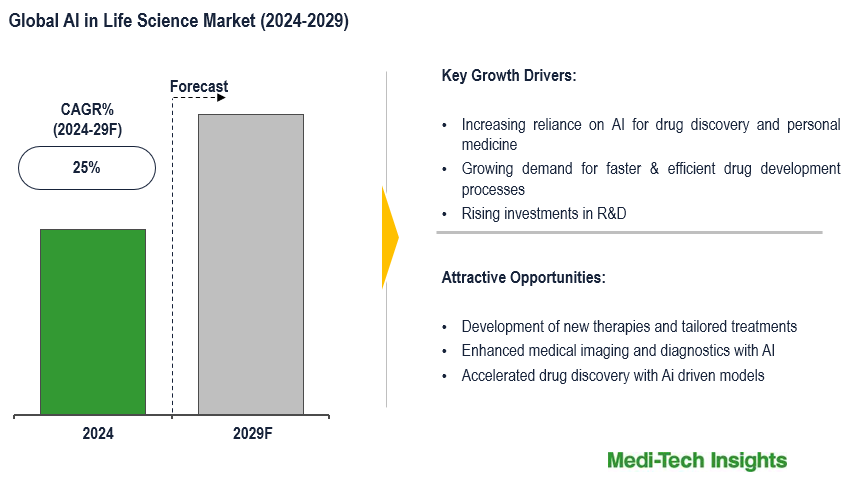
AI in Life Sciences Market Size, Share, Industry Innovations, Challenges, and Opportunities (2024-2029)
The AI in Life Science Market is anticipated to experience a remarkable compound annual growth rate (CAGR) of around 25% in the coming years, highlighting the increasing reliance on AI technologies across various applications in life sciences. The life sciences market is witnessing a transformative expansion due to the integration of artificial intelligence (AI), particularly in areas such as drug development, personalized therapies, and predictive analytics. With its capability to streamline genomic analysis and optimize clinical trials, AI is rapidly becoming a cornerstone of innovation in healthcare. To learn more about the research report, download a sample report.
Artificial Intelligence (AI) refers to the use of advanced algorithms and computational models to simulate human intelligence in machines, enabling them to perform tasks like data analysis, pattern recognition, and decision-making. In the life sciences industry, AI is revolutionizing the field by accelerating drug discovery, personalizing medicine, and improving diagnostics through rapid data processing and predictive analytics. AI is also enhancing research efficiency by automating complex processes and enabling the development of new therapies, ultimately leading to more effective treatments and better patient outcomes.
Emerging Trends and Transformative Impacts of AI in Life Sciences
The life sciences sector is witnessing a surge in AI-driven innovations, fundamentally altering the landscape of healthcare, drug development, and research. One of the most significant trends is the acceleration of drug discovery, where AI models are employed to explore vast chemical spaces, rapidly designing new drug candidates by simulating molecular interactions. This is particularly transformative in areas like protein design, where AI is enabling the development of treatments for complex diseases such as Alzheimer’s and certain cancers. For instance,
- In July 2024, Insilico launched the PandaOmics Box, an AI-powered hardware platform designed for on-premise drug discovery and personalized medicine research, integrating Insilico's generative biology AI, extensive scientific databases, and advanced hardware to operate securely and efficiently in an offline environment
- In August 2022, Atomwise announced a strategic and exclusive research collaboration with Sanofi, utilizing its AtomNet platform for the computational discovery and research of five drug targets
AI is also at the forefront of personalized medicine, where it analyzes individual genetic profiles to predict patient responses to various therapies, leading to more effective and tailored treatment plans. In synthetic biology, AI assists in the design of synthetic organisms and biological systems, suggesting DNA sequences for the creation of organisms that produce biofuels, biodegradable plastics, and new medicines.
In the realm of medical imaging and diagnostics, AI is enhancing the resolution of images from lower-quality scans, improving the detection of subtle abnormalities. This capability is vital for the early and accurate diagnosis of conditions like cancer. Additionally, AI-powered virtual health assistants and chatbots are becoming increasingly common, providing patient support by answering queries, scheduling appointments, and offering mental health assistance.
The optimization of clinical trials is another area where AI is making a significant impact. By simulating trial outcomes and predicting patient responses, AI helps design more efficient and cost-effective trials, ensuring the safe and effective development of new therapies. These trends underscore the growing influence of AI in driving innovation across drug discovery, personalized medicine, synthetic biology, diagnostics, patient care, and clinical trials. For instance,
- In June 2024, Salesforce launched its AI-powered Life Sciences Cloud, designed to transform patient and healthcare professional engagement for Pharma and MedTech companies by streamlining clinical operations and enhancing trial recruitment through data-driven, automated, and personalized solutions
To learn more about this report, download the PDF brochure
How AI is Revolutionizing Life Sciences: From Predictive Models to Ethical Insights
Artificial Intelligence (AI) is playing a pivotal role in transforming the life sciences, driving breakthroughs and enhancing efficiencies across various domains. One of the key ways AI is making an impact is through predictive modeling, where it forecasts disease progression by analyzing vast datasets from clinical studies. This enables earlier intervention and more precise treatment strategies, particularly in complex conditions like cancer and neurodegenerative disorders. For instance,
Real-time data analysis and decision support are other areas where AI is making significant strides. AI-driven platforms continuously monitor patient vitals and lab results, providing healthcare professionals with decision support that allows for timely interventions, ultimately improving patient outcomes. In the field of genomics, AI is revolutionizing the interpretation of genomic data, helping researchers and clinicians uncover the complex relationships between genes and diseases, leading to the development of targeted therapies and personalized medicine. For instance,
- In August 2023, Kakao Healthcare Corp., the digital healthcare division of South Korea's Kakao Corp., entered into a business agreement with Novo Nordisk to integrate its "Project Gamma" digital blood glucose management service with Novo Nordisk's upcoming "Mallya Smart Sensor," aiming to provide a comprehensive platform for real-time monitoring of blood glucose levels and insulin injection records for chronic disease management
AI is also automating labour-intensive laboratory processes, increasing efficiency and reducing human error. This allows scientists to focus on more complex aspects of research. Moreover, AI-powered wearable medical devices and remote patient monitoring are transforming patient care, particularly for chronic conditions, by providing real-time health metrics and enabling proactive management.
Beyond these practical applications, AI is also assisting in addressing ethical and regulatory challenges within the life sciences sector. By analyzing historical data and regulatory guidelines, AI provides insights into compliance risks and ethical considerations, ensuring that new technologies and treatments adhere to industry standards. Furthermore, AI is advancing bioinformatics and systems biology by enabling the integration and analysis of diverse biological data sources, facilitating the discovery of new biomarkers, therapeutic targets, and complex biological models
Challenges and Constraints
Despite the promising trajectory, the AI in life sciences market grapples with several obstacles. Key challenges include concerns regarding data privacy and security, regulatory complexities, and the difficulties of incorporating AI into established healthcare frameworks. Furthermore, the absence of standardized data formats and the necessity for large, high-quality datasets can impede the effective development of AI models. Addressing ethical considerations and potential biases within AI algorithms is crucial for building trust and ensuring successful implementation.
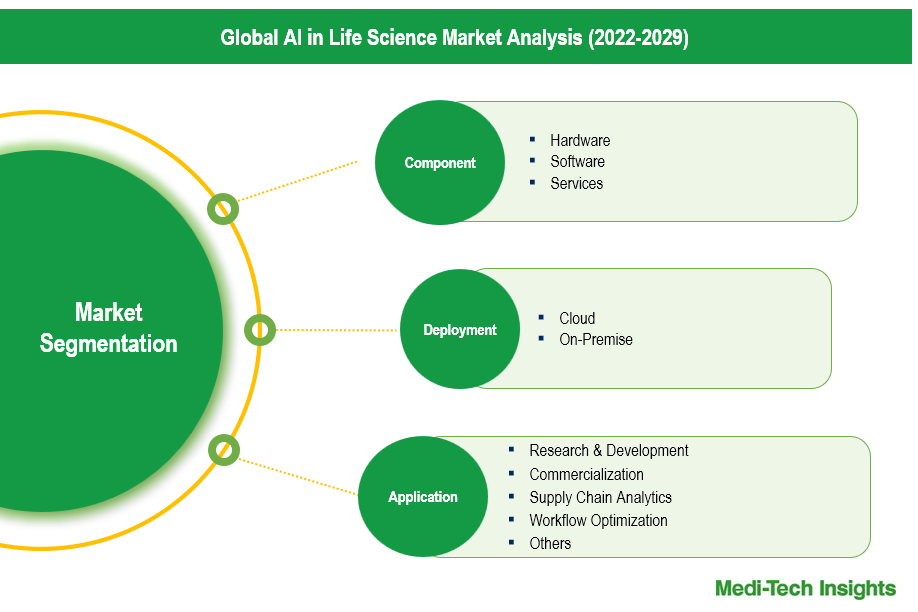
To learn more about this report, download the PDF brochure
Component Segment Outlook
AI in Life Science market is integrated across three major components: hardware, software, and services, each playing a crucial role in advancing innovation and efficiency. Hardware components include AI-powered devices, computational infrastructure, and specialized equipment that enable high-speed data processing and analysis, essential for tasks like genomic sequencing and drug discovery. Software encompasses AI algorithms, machine learning models, and platforms that drive data analytics, predictive modeling, and automation in research and clinical settings. This segment often dominates market share due to its critical role in enabling AI functionalities. Services involve consulting, integration, and maintenance, ensuring that AI solutions are effectively implemented and optimized within healthcare organizations. This segment supports the ongoing adoption and scaling of AI technologies, making it an essential part of the overall ecosystem.
Deployment Segment Outlook
AI in Life Science market deployment segment primarily include two subsegments cloud-based and on-premise solutions, each catering to different organizational needs. Cloud-based AI is favoured for its scalability, flexibility, and cost-effectiveness, making it ideal for drug discovery and clinical data analysis applications. This segment leads in market share due to its ease of access and lower costs. On-premise AI is preferred by organizations needing enhanced data security and compliance with regulatory standards, especially in sensitive areas like genomic research. While smaller in market share, on-premise solutions are crucial for maintaining control over proprietary data and meeting strict privacy requirements.
The AI in Life Science Market: Regional Variations
North America stands at the forefront of the AI In Life Sciences market, propelled by extensive research initiatives, substantial investments in healthcare technology, and a concentration of leading biotechnology and pharmaceutical firms. Europe follows closely, supported by government initiatives and a growing emphasis on personalized healthcare solutions. Simultaneously, the Asia-Pacific region is becoming a key player, fueled by the growing adoption of AI technologies in healthcare, the expansion of clinical trials, and increasing investments in AI-focused life sciences research, particularly in nations like China, Japan, and India.
Competitive Landscape Analysis
The AI in Life Science market is marked by the presence of established key players such as IBM Corporation, Atomwise, Inc., Nuance Communications, Inc., NuMedii, Inc., AiCure LLC., APIXIO, Inc., Insilico Medicine, Inc., Enlitic, Inc. Sensely, Inc., Zebra Medical Vision. (Nanox AI) among others.
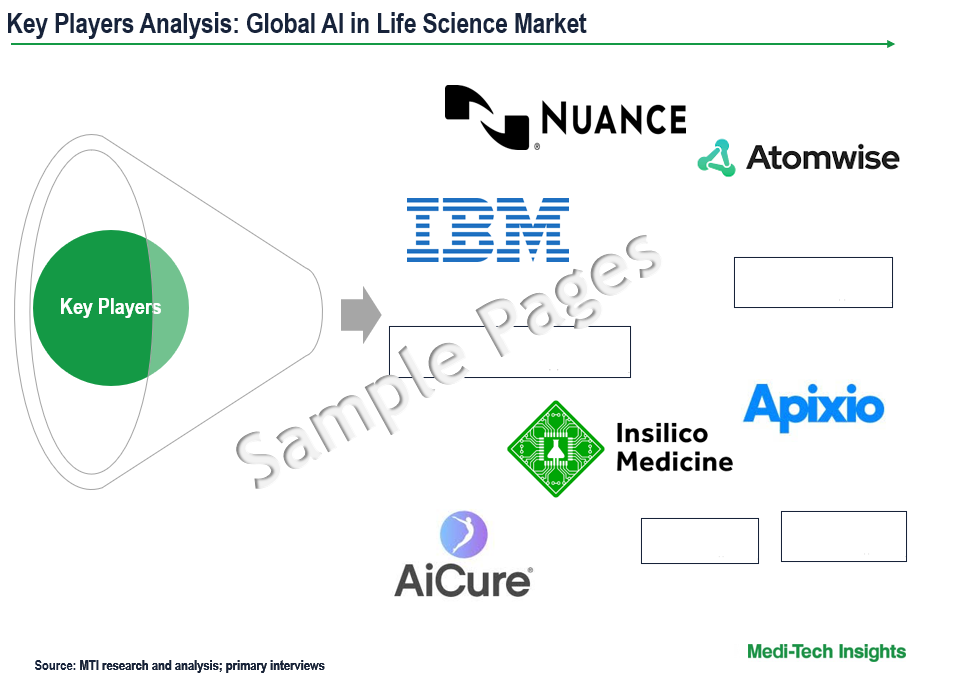
Get a sample report for competitive landscape analysis
Organic/ and Inorganic Growth Strategies Adopted by Players to Establish Their Foothold in the Market
Players operating in this market are adopting both organic and inorganic growth strategies such as collaborations, acquisitions, and new product launches to garner market share. For instance,
- In June 2024, Eli Lilly and Company announced a collaboration with OpenAI to harness OpenAI's generative AI technology for the invention of novel antimicrobials aimed at treating drug-resistant pathogens
- In May 2024, Sanofi, Formation Bio, and OpenAI announced a groundbreaking collaboration to create AI-powered software designed to expedite drug development and efficiently deliver new medicines to patients, combining data, software, and tailored models to develop specialized solutions throughout the drug development lifecycle
- In November 2023, Boehringer Ingelheim and IBM announced a collaboration that will allow Boehringer to leverage IBM's foundation model technologies to discover new candidate antibodies for the development of effective therapeutics
The global AI in Life Science market is growing and is expected to gain further momentum in the coming years due to growing cases of chronic diseases, rising demand for personalized medicine, significant investments in R&D, technological advancements, and aggressive organic and inorganic growth strategies followed by the players.
AI in Life Science Market Scope
| Report Scope | Details |
| Base Year Considered | 2023 |
| Historical Data | 2022 - 2023 |
| Forecast Period | 2024 - 2029 |
| Growth Rate | CAGR 25% |
| Segment Scope | Component, Deployment, Application, and End User |
| Regional Scope |
|
| Key Companies Mapped | IBM Corporation, Atomwise, Inc., Nuance Communications, Inc., NuMedii, Inc., AiCure LLC., APIXIO, Inc., Insilico Medicine, Inc., Enlitic, Inc. Sensely, Inc., and Zebra Medical Vision. (Nanox AI) among others |
| Report Highlights | Market Size & Forecast, Growth Drivers & Restraints, Trends, Competitive Analysis |
Key Strategic Questions Addressed
-
What is the market size & forecast for the Global AI in Life Science Market?
-
What are the historical, present, and forecasted market shares and growth rates of various segments and sub-segments of the Global AI in Life Science Market?
-
How has COVID-19 impacted the Global AI in Life Science Market?
-
What are the major growth drivers, restraints/challenges impacting the market?
-
What are the opportunities prevailing in the market?
-
What is the investment landscape?
-
Which region has the highest share in the global market? Which region is expected to witness the highest growth rate in the next 5 years?
-
Who are the major players operating in the market? What is the competitive positioning of key players?
-
Who are the new players entering the market?
-
What are the key strategies adopted by players?
- Introduction
- Introduction
- Market Scope
- Market Definition
- Segments Covered
- Regional Segmentation
- Research Timeframe
- Currency Considered
- Study Limitations
- Stakeholders
- List of Abbreviations
- Key Conferences and Events (2023-2024)
- Research Methodology
- Secondary Research
- Primary Research
- Market Estimation
- Bottom-Up Approach
- Top-Down Approach
- Market Forecasting
- Executive Summary
- AI in Life Science Market Snapshot (2023-2029)
- Segment Overview
- Regional Snapshot
- Competitive Insights
- Market Overview
- Market Dynamics
- Drivers
- Growing reliance on AI for drug discovery and personalized medicine
- AI's ability to streamline genomic analysis and optimize clinical trials
- Growing demand for faster, more efficient drug development
- Advancements in AI technology for predictive modeling and data analysis
- Increased investments in AI-driven healthcare innovations
- Restraints
- Data privacy and security concerns
- Regulatory complexities and ethical considerations
- Challenges in integrating AI into existing healthcare frameworks
- Opportunities
- Development of new therapies and tailored treatments
- AI-powered platforms for secure, on-premise drug discovery
- Key Market Trends
- Acceleration of drug discovery with AI-driven models
- Enhanced medical imaging and diagnostics with AI
- Unmet Market Needs
- Industry Speaks
- Porter’s Five Forces Analysis
- Regulatory Analysis
- Drivers
- Market Dynamics
- Global AI in Life Science Market Size & Forecast (2022-2029), By Component Type, USD Million
- Introduction
- Software
- Hardware
- Services
- Global AI in Life Science Market Size & Forecast (2022-2029), By Deployment Type, USD Million
- Introduction
- Cloud
- On-Premise
- Global AI in Life Science Market Size & Forecast (2022-2029), By Application Type, USD Million
- Introduction
- Research and Development
- Commercialization
- Supply Chain Analytics
- Workflow Optimization
- Personalized Medicine & Patient Management
- Others
- Global AI in Life Science Market Size & Forecast (2022-2029), By End User, USD Million
- Introduction
- Hospital
- Pharma and Biotechnology Companies
- Academic and Research Institutes
- Others
- Global AI in Life Science Market Size & Forecast (2022-2029), By Region, USD Million
- Introduction
- AI in Life Science Market Size & Forecast (2022-2029), By Country, USD Million
- US
- Market Size & Forecast, By Component (USD Million)
- Market Size & Forecast, By Deployment (USD Million)
- Market Size & Forecast, By Application (USD Million)
- Market Size & Forecast, By End User (USD Million)
- Canada
- Market Size & Forecast, By Component (USD Million)
- Market Size & Forecast, By Deployment (USD Million)
- Market Size & Forecast, By Application (USD Million)
- Market Size & Forecast, By End User (USD Million)
- AI in Life Science Market Size & Forecast (2022-2029), By Country, USD Million
- UK
- Market Size & Forecast, By Component (USD Million)
- Market Size & Forecast, By Deployment (USD Million)
- Market Size & Forecast, By Application (USD Million)
- Market Size & Forecast, By End User (USD Million)
- Germany
- Market Size & Forecast, By Component (USD Million)
- Market Size & Forecast, By Deployment (USD Million)
- Market Size & Forecast, By Application (USD Million)
- Market Size & Forecast, By End User (USD Million)
- France
- Market Size & Forecast, By Component (USD Million)
- Market Size & Forecast, By Deployment (USD Million)
- Market Size & Forecast, By Application (USD Million)
- Market Size & Forecast, By End User (USD Million)
- Italy
- Market Size & Forecast, By Component (USD Million)
- Market Size & Forecast, By Deployment (USD Million)
- Market Size & Forecast, By Application (USD Million)
- Market Size & Forecast, By End User (USD Million)
- Spain
- Market Size & Forecast, By Component (USD Million)
- Market Size & Forecast, By Deployment (USD Million)
- Market Size & Forecast, By Application (USD Million)
- Market Size & Forecast, By End User (USD Million)
- Rest of Europe
- Market Size & Forecast, By Component (USD Million)
- Market Size & Forecast, By Deployment (USD Million)
- Market Size & Forecast, By Application (USD Million)
- Market Size & Forecast, By End User (USD Million)
- Asia Pacific (APAC) AI in Life Science Market Size & Forecast (2022-2029), By Country, USD Million
- China
- Market Size & Forecast, By Component (USD Million)
- Market Size & Forecast, By Deployment (USD Million)
- Market Size & Forecast, By Application (USD Million)
- Market Size & Forecast, By End User (USD Million)
- Japan
- Market Size & Forecast, By Component (USD Million)
- Market Size & Forecast, By Deployment (USD Million)
- Market Size & Forecast, By Application (USD Million)
- Market Size & Forecast, By End User (USD Million)
- India
- Market Size & Forecast, By Component (USD Million)
- Market Size & Forecast, By Deployment (USD Million)
- Market Size & Forecast, By Application (USD Million)
- Market Size & Forecast, By End User (USD Million)
- Rest of Asia Pacific
- Market Size & Forecast, By Component (USD Million)
- Market Size & Forecast, By Deployment (USD Million)
- Market Size & Forecast, By Application (USD Million)
- Market Size & Forecast, By End User (USD Million)
- Latin America (LATAM) AI in Life Science Market Size & Forecast (2022-2029), USD Million
- Market Size & Forecast, By Component (USD Million)
- Market Size & Forecast, By Deployment (USD Million)
- Market Size & Forecast, By Application (USD Million)
- Market Size & Forecast, By End User (USD Million)
- Middle East & Africa (MEA) AI in Life Science Market Size & Forecast (2022-2029), USD Million
- Market Size & Forecast, By Component (USD Million)
- Market Size & Forecast, By Deployment (USD Million)
- Market Size & Forecast, By Application (USD Million)
- Market Size & Forecast, By End User (USD Million)
- China
- UK
- US
- Competitive Landscape
- Key Players and their Competitive Positioning
- Competitive Positioning of Key Players (2022)
- Offerings Assessment, By Player
- Key Strategies Assessment, By Player (2021-2023)
- New Product & Service Launches
- Partnerships, Agreements, & Collaborations
- Mergers & Acquisitions
- Geographic Expansion
- Key Players and their Competitive Positioning
- Company Profiles*
(Business Overview, Financial Performance**, Products Offered, Recent Developments)
- IBM Corporation
- Atomwise, Inc.
- Nuance Communications, Inc.
- NuMedii, Inc.
- AiCure LLC.
- APIXIO, Inc.
- Insilico Medicine, Inc.
- Enlitic, Inc.
- Sensely, Inc.
- Zebra Medical Vision (Nanox AI)
The study has been compiled based on extensive primary and secondary research.
Secondary Research (Indicative List)
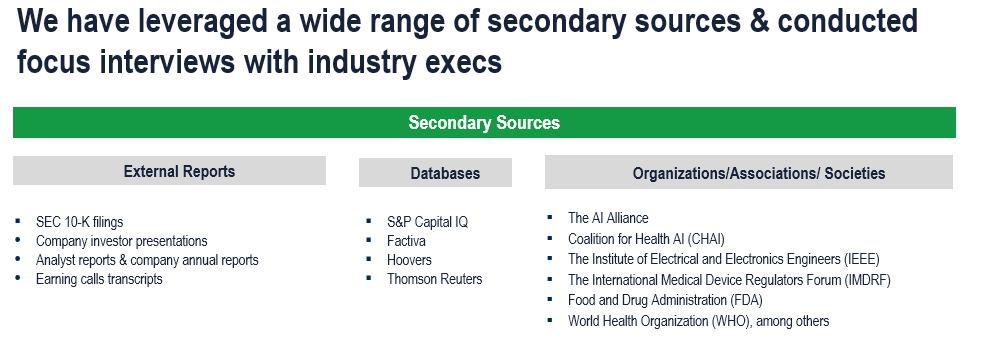
Primary Research
To validate research findings (market size & forecasts, market segmentation, market dynamics, competitive landscape, key industry trends, etc.), extensive primary interviews were conducted with both supply and demand-side stakeholders.
Supply Side Stakeholders:
- Senior Management Level: CEOs, Presidents, Vice-Presidents, Directors, Chief Technology Officers, Chief Commercial Officers
- Mid-Management Level: Product Managers, Sales Managers, Brand Managers, Business Development Managers, Consultants
- Demand Side Stakeholders: Stakeholders in Hospitals, Pharma and Biotechnology Companies, Academic and Research Institutes and Other End Users
Breakdown of Primary Interviews
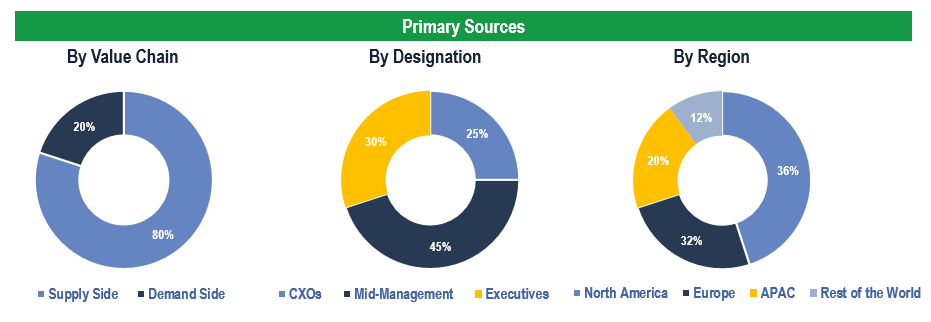
Market Size Estimation
Both ‘Top-Down and Bottom-Up Approaches’ were used to derive market size estimates and forecasts.
Data Triangulation
Research findings derived through secondary sources & internal analysis were validated with Primary Interviews, Internal Knowledge Repository, and Company Sales Data.

